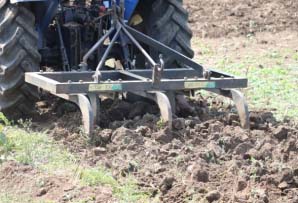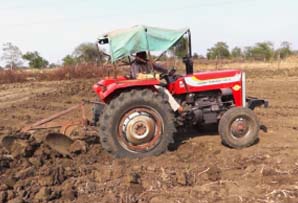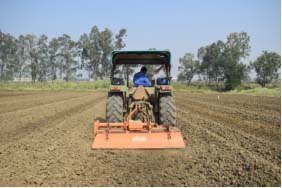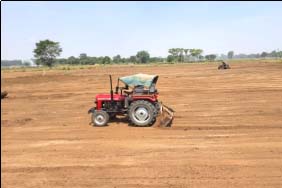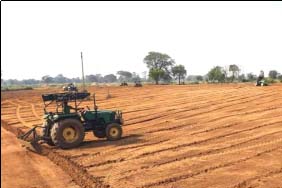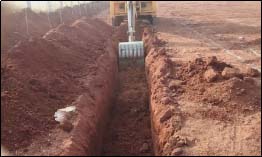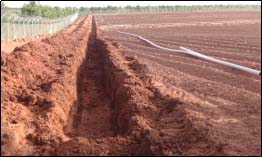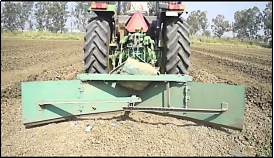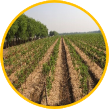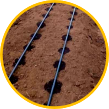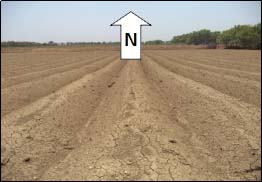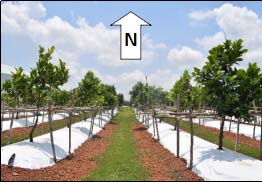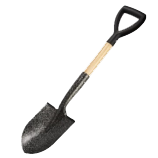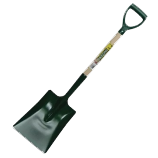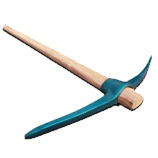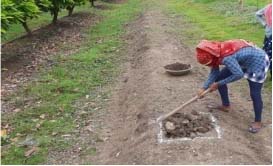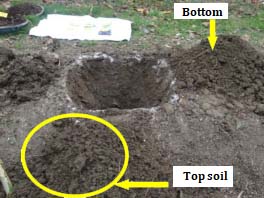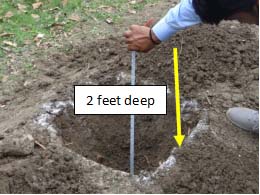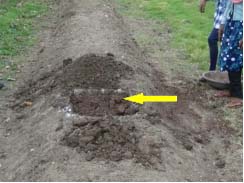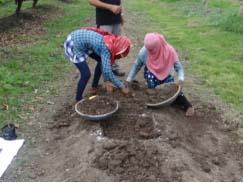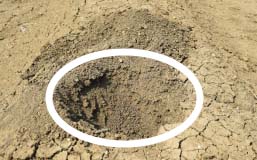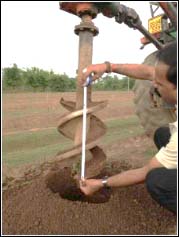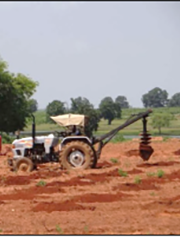| S.N. | PRACTICES |
| 1. | Elevation Surveys |
| 2. | Deep Ploughing |
| 3. | Breaking Clods |
| 4. | Leveling & Slope |
| 5. | Drainage Trench |
| 6. | Raised Beds |
| 7. | Spacing |
| 8. | Digging Pits |
STEP 1 – ELEVATION SURVEYS
Precision contour surveys are essential on low slope areas. On higher slope region (slopes > 0.5%) it may not be needed because the slope direction is much less likely to be altered by minor elevation changes. The reasons for undertaking a precision survey are –
- To detect the dominant direction of slope.
- To identify humps and hollows that will change the direction of surface flows.
- To identify the need for local drains or cross drains to remove water from small depression.
- To plan the orientation of Raised Bed and the best location to dispose of water from the major drain at lower end of the Raised Bed. Surveyors with the capability of undertaking precise elevation surveys and producing maps are available locally.
STEP 2 – DEEP PLOUGHING
Deep ploughing of field is done twice with 12-18 inches deep plough.
Why deep ploughing is required?
Deep ploughing is required for two major benefits.
- It breaks the hard pan of soil, allowing better root growth & better penetration of water/ moisture.
- Exposing soil borne insects/pests to harsh atmospheric conditions, which helps in reducing their population in field.
IMPLEMENTS FOR DEEP PLOUGHING
For more details click here: https://youtu.be/IsS-asWQdjE?si=SpqTx_tfvej-7jb5
STEP 3 – BREAKING CLODS
- After deep ploughing, clods of soil are broken with a rotavator.
- This is to be done few days after deep ploughing when moisture is reduced.
Benefits: This gives better texture to soil and makes it suitable for leveling & plantation.
ROTAVATOR BREAKING CLODS
For more details click here: https://www.youtube.com/watch?v=8VTHz50zNK4
STEP 4 – LEVELING & SLOPE
Leveling of field is done to avoid water logging in uneven pockets & for convenience of activating agricultural practices, a slope of 0.5 % is recommended to get runoff excess water.
Benefits:
- This is made to drain out excess water minimizing soil erosion.
- Leveling of 200-250 ft long patch at a time with drainage proved to be efficient and cost effective.
For more details click here: https://youtu.be/4lbEFb4dKiU?si=8mXg36dphED1hKrs
STEP 5 – DRAINAGE TRENCH
- After leveling the field, a main drainage trench – 2 ft deep and 2/3 ft wide is made.
Benefits
- This ensures collection & drain of excess water from the orchard area.
- This practice helps in reducing the excess moisture in the field.
STEP 6 – RAISED BED
What is Raised Bed?
The manually elevated/mounted soil mass at a certain height from the ground where plants are transplanted is called a Raised Bed.

Objectives of making raised bed –
The desired outcomes from these management objectives are to ensure the Raised Beds function properly, that is, they:
- Drain and aerate freely, and thus prevent water logging.
- Increase root growth and proliferation, thereby reinforcing the loose structure, minimizing subsidence, and increasing soil organic matter.
- Increases plant water use efficiency, and thereby increases production.
Raised Bed need to be prepared at least 15 days before plantation.
For more details click here: https://youtu.be/SsRf8fbJll0?si=w-g-IF8obOnqwUc2
Benefits
Bed Orientation
Orientation of raised bed in North-South direction is found best.
Reason
- The North-South orientation allows for an even exposure of the sunlight, which maximizes the chances of uniform crop development.
- Crops planted on a predominantly east-west orientation have the rows closest to the northern shoulder of the bed exposed to sunlight for most of the day. This causes greater soil evaporation from the northern shoulder and results in one or two crop rows growing less and yielding poor than the crop rows on the remainder of the bed.
RAISED BED & PLANTATION IN NORTH – SOUTH DIRECTION
Size of Raised beds
- In waterlogged areas, raised beds are made 3 times the level of water to protect roots from excess moisture.
- Height of the Raised beds – 12-18 inches.
- Width of the Raised beds – 30-36 inches.
N.B – The size of raised beds varies in different soil types and rainfall area.
Bed Preparation
- The soil masses are drawn on a line with help of a ridger up to a required height.
- The elevated soil thus should be well finished manually after the work is completed mechanically.
- The beds should be soiled well with irrigation, so that the soil becomes compact and helps the plant for better anchorage.
STEP 7 – SPACING
The minimum distance between any two fruit plants is referred as spacing and this varies from plant to plant.
Suggested spacing for VNR Jackfruit Orchard:
Row 15 ft. x Plant 15 ft. or 20 x 15 spacing found suitable for VNR Jackfruit
= 193 plants/ Acre or 145 plants / Acre.
= 482 plants/Ha. or 363 plants / Ha.
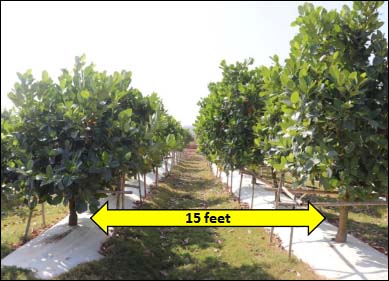
STEP 8 – DIGGING PITS
Pits are required to loosen the soil, break the hard pan and to create moisture availability for good root development and plant growth. It also helps in placement of required nutrients with well decomposed FYM.
- Pits are dug on raised beds either manually or mechanically.
- Mechanical digging is efficient and cost-effective.
1. Manual Method
Pit digging with size matrix of 2L×2W×2D ft with application of FYM and basal dosages is an essential activity before plantation of Jackfruit Plant.
Tools for pit digging:
Steps to be followed for manual operation:
2. Mechanical Digging
- For this purpose, tractor mounted post-hole digger with auger diameter 20-22 inches can be used.
- Post hole digger can be sourced from Agri. Implement Shops or Contractors of Forest / Electricity Departments.
Tractor driven digger and two drivers can make 300 / 400 pits per day on the raised bed. Manually, one labour can make max. 15 – 20 pits/day (estimated).
For more details click here: https://www.youtube.com/shorts/L1zbww0d3BE
References:
• https://www.ncbi.nlm.nih.gov/pmc/articles/PMC6339770/
•https://www.researchgate.net/publication/330201154_Nutritional_and_Health_Benefits_of_Jackfruit_Artocarpus_heterophyllus_Lam_A_Review
• https://www.flipkart.com/tadso-lid-garden-tool-gaiti-kudaal-wooden-handle-heavy-duty-agricultural hovel/p/itm58f0208aef4c7 –
• https://www.scottdirect.com/tools-equipment/hand-tools/shovels-rakes/square-mouth-shovels
• https://www.jawad-alsaffar.com/store/en/all-categories/14210-sh-9-shovel-68-x155cm.html

